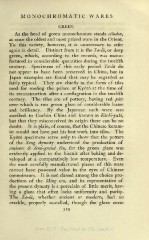Page 393 - Oriental Series Japan and China, Brinkly
P. 393
MONOCHROMATIC WARES
GREEN.
At the head of green monochromes stands celadon,
at once the oldest and most prized ware in the Orient.
To this variety, however, it is unnecessary to refer
again in detail. Distinct from it is the Ta-lu, or deep
green, which, according to the records, was manu-
factured in considerable quantities during the twelfth
century. Specimens of this early period Ta-lu do
not appear to have been preserved in China, but in
Japan examples are found that may be regarded as
fairly typical. They are chiefly in the form of tiles
used for roofing the palace at Kyoto at the time of
its reconstruction after a conflagration in the twelfth
century. The tiles are of pottery, having red pate
over which is run green glaze of considerable lustre
and brilliancy. By the Japanese such ware was
ascribed to Cochin China and known as Kochi-yaki,
but that they misconceived its origin there can be no
doubt. It is plain, of course, that the Chinese keram-
ist would not have put his best work into tiles. The
Kyoto specimens serve only to show that the potters
of the Sung dynasty understood the production of
couleurs de demi-grand feu, for the green glaze was
evidently applied to the biscuit after baking and de-
veloped at a comparatively low temperature. Even
the most carefully manufactured pieces of this ware
cannot have possessed value in the eyes of Chinese
connoisseurs. It is not classed among the choice pro-
ductions of the Ming era, and its representative of
the present dynasty is a porcelain of little merit, hav-
ing a glaze that often lacks uniformity and purity.
The Ta-lu, whether ancient or modern, had no
crackle, properly so-called, though the glaze occa-

